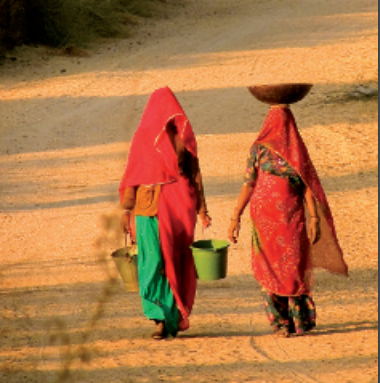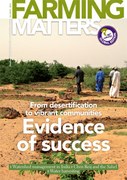Defining “the future we want” for the planet we rely on, world leaders at Rio+20 resolved to achieve a land-degradation neutral world. Forging a global partnership to reverse and prevent desertification/land degradation and to mitigate the effects of drought in affected areas in order to support poverty reduction and environmental sustainability, the United Nations Convention to Combat Desertification (UNCCD), one of the three international treaties called for by the 1992 Earth Summit, remains at the core of today’s most pressing development challenges.
An approach to funding sustainable land management
The UNCCD established the Global Mechanism (GM) to increase the effectiveness of existing financial mechanisms and promote actions leading to the mobilisation of substantial financial resources to combat land degradation and desertification. Since 1999, the GM has worked with the governments of several dozen affected countries to formulate comprehensive anti-desertification financing strategies, fully integrating them in their development legislation and policies.
These financing strategies are structured, yet flexible, processes that support countries to assemble a variety of sources – domestic, international, public and private – to fund land and natural resource management. The strategies should serve as the foundation for an even wider-reaching policy, ultimately leading to long-term and lasting investment frameworks. Among numerous recent examples, frameworks have been designed and launched in Ethiopia, Guatemala, Viet Nam and Zambia.
In addition to connecting governments with potential donors, the GM facilitates access to innovative opportunities, for example, by encouraging private sector investments or market-based mechanisms to promote sustainable land-use practices, such as compensation schemes, ecotourism and eco-labelling.
The UNCCD addresses the vital issues of improved productivity of land as well as the rehabilitation, conservation and sustainable management of land and water resources.
The 195 Parties (194 countries and the European Union) that have ratified the Convention work together to improve the living conditions for people, especially in drylands, where some of the most vulnerable ecosystems and peoples can be found. It pursues its goals with a bottom-up approach – empowering the people touched by desertification and land degradation to fight it by providing the instruments and building the capacities of local authorities and civil society.
Land degradation comes at a huge cost, and not just to the 1.5 billion people across the planet directly affected by it. The 12 million hectares lost to land degradation annually have the potential to produce 20 million tons of grain – food that would minimise growing food insecurity and alleviate hunger.
“One of the major weaknesses in the current global food production system is the absence of policy incentives in three key areas in food production – women, dryland productivity and proper land-use accounting”, said Luc Gnacadja, Executive Secretary of the UNCCD, adding that women make up more than 40% of the labour force, but represent only 3 to 20% of landholders.
The world’s drylands – the arid, semi-arid and dry sub-humid zones – make up 44% of all cultivated systems. But land degradation in the drylands and elsewhere is undermining global food production, and with it food price stability.
Food production consumes finite water and land resources. Already, 70% of all fresh water resources is used in agriculture. As long as the cost of land degradation and water consumption are omitted in food pricing, food insecurity will likely persist due to speculation about the land available to meet the growing food demand.
Mainstreaming the costs of land and water renewal in all food producing would stabilise the market in the long run and enable agricultural producers to take better care of the land.
Successful examples
The successes of small-scale food producers are valuable in identifying key policy gaps and solutions. In Burkina Faso, for example, some communities have not only become more resilient to drought, but are also producing surplus grain through farmer-managed natural regeneration practices and agroforestry. These are land-use practices built on a mix of conventional science and indigenous farming techniques that improve land productivity. Their successes show that there are immediate benefits for households and national and global benefits of food security to be reaped from mainstreaming sustainable land management in agricultural practice.
In his message on World Food Day in October 2012, Gnacadja explained that land degradation in the drylands and elsewhere is undermining global food production and food price stability. The head of the UNCCD pointedly asked, “How can we sustain stability in food production when the land and soil resources that are the backbone of agriculture are eroded year after year?”
To meet the expected dramatic rise in food demand, we cannot count on agricultural intensification whose production schemes degrade land and soil, destroy ecosystems, have expensive input costs and yields that have stagnated and are increasingly vulnerable to the impacts of climate change. Conversely, production systems based on the intensification of locally available and adapted biodiversity, using local knowledge as well as local ecosystems, have been shown to significantly contribute to reducing hunger, improving livelihoods, protecting and regenerating land, soils, water and biodiversity, enhancing resilience to climate change.
Working together
The work of the conventions on biodiversity, climate change and land goes hand-in-hand. Bio-intensive production schemes, such as organic agriculture, agro-ecological agriculture and agroforestry, have a role to play in avoiding land degradation and restoring degraded lands. They could be called “Sustainable Land Management practices applied to agriculture” under UNCCD, or “Climate-Smart Agriculture” under the Climate Change Convention (UNFCCC), and are well established throughout the world.
The Rio+20 outcome to strive to achieve a land-degradation neutral world signals a strong desire to change by avoiding the degradation of land in new areas and by improving the quality of land that is degraded every year. But this intention must be turned into concrete action – a timeline and mechanisms for its achievement are needed. In fact, land-degradation neutral must be among the Sustainable Development Goals to succeed the Millennium Development Goals in 2015 and pursued on the grassroots level by all of us.
Established in 1994, the United Nations Convention to Combat Desertification, a legally binding international agreement linking environment and development to sustainable land management, addresses specifically the arid, semi-arid and dry sub-humid areas, known as the drylands, where some of the most vulnerable ecosystems and peoples can be found.
Mia Rowan (m.rowan@global-mechanism.org) works as English editor and social media specialist at the Global Mechanism of the UNCCD. The Global Mechanism supports developing countries to increase investments in sustainable land management to help reverse, control and prevent land degradation, while promoting economic and social development.


